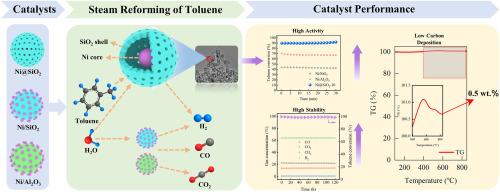利用高效稳定的Ni@SiO2蛋黄壳催化剂制备甲苯蒸汽重整富氢合成气
IF 8.3
2区 工程技术
Q1 CHEMISTRY, PHYSICAL
引用次数: 0
摘要
催化重整技术在处理生物质气化焦油方面具有重要的潜力。然而,设计出高活性、低碳沉积和长期稳定性的催化剂仍然是一个挑战。本研究合成了Ni@SiO2黄壳催化剂,并对其在甲苯蒸汽重整中的活性和稳定性进行了评价。Ni@SiO2-10催化剂表现出优异的稳定性和活性,在120小时的测试期间保持100%的甲苯转化率,重整后几乎没有碳沉积。而初湿浸渍法合成的Ni/SiO2和Ni/Al2O3催化剂在使用后表现出明显的烧结和积碳现象。在相同的支撑条件下,Ni@SiO2将甲苯蒸汽重整的初始反应温度从462℃降低到418℃。Ni负载的增加显著增加了活性位点的数量,减小了SiO2微球的尺寸,使SiO2壳层变薄,从而将甲苯转化率从72%提高到100%。温度和GHSV(气体时空速)对催化性能有显著影响,转化率稳定在700℃,GHSV = 24500 h−1。Ni@SiO2的蛋黄壳结构促进了Ni的高度分散,减少了团聚和碳沉积,这是其高活性和稳定性的关键。这些发现对生物质焦油重整催化剂的开发具有重要意义。本文章由计算机程序翻译,如有差异,请以英文原文为准。

Hydrogen-rich syngas production from steam reforming of toluene using highly active and stable Ni@SiO2 yolk-shell catalysts
Catalytic reforming technology holds significant potential for treating biomass gasification tar. However, the design of catalysts that offer high activity, low carbon deposition, and long-term stability remains a challenge. In this study, Ni@SiO2 yolk-shell catalysts were synthesized and evaluated for their activity and stability in toluene steam reforming. The Ni@SiO2-10 catalyst demonstrated excellent stability and activity, maintaining a 100 % toluene conversion rate over a 120-h test period with virtually no carbon deposition after reforming. In contrast, Ni/SiO2 and Ni/Al2O3 catalysts, synthesized by incipient wetness impregnation, showed significant sintering and carbon deposition after use. Under identical support conditions, Ni@SiO2 reduced the initial reaction temperature for toluene steam reforming from 462 °C to 418 °C. Increasing the Ni loading significantly enhanced the number of active sites, decreased the size of the SiO2 microspheres, and thinned the SiO2 shell layer, thereby elevating the toluene conversion from 72 % to 100 %. Both temperature and the GHSV (gas hourly space velocity) had a significant impact on catalytic performance, with conversion rates stabilizing at 700 °C and an GHSV = 24500 h−1. The yolk-shell structure of Ni@SiO2 promoted high Ni dispersion, reducing aggregation and carbon deposition, which were key to its high activity and stability. These findings are crucial for the development of catalysts for biomass tar reforming.
求助全文
通过发布文献求助,成功后即可免费获取论文全文。
去求助
来源期刊

International Journal of Hydrogen Energy
工程技术-环境科学
CiteScore
13.50
自引率
25.00%
发文量
3502
审稿时长
60 days
期刊介绍:
The objective of the International Journal of Hydrogen Energy is to facilitate the exchange of new ideas, technological advancements, and research findings in the field of Hydrogen Energy among scientists and engineers worldwide. This journal showcases original research, both analytical and experimental, covering various aspects of Hydrogen Energy. These include production, storage, transmission, utilization, enabling technologies, environmental impact, economic considerations, and global perspectives on hydrogen and its carriers such as NH3, CH4, alcohols, etc.
The utilization aspect encompasses various methods such as thermochemical (combustion), photochemical, electrochemical (fuel cells), and nuclear conversion of hydrogen, hydrogen isotopes, and hydrogen carriers into thermal, mechanical, and electrical energies. The applications of these energies can be found in transportation (including aerospace), industrial, commercial, and residential sectors.
 求助内容:
求助内容: 应助结果提醒方式:
应助结果提醒方式:


